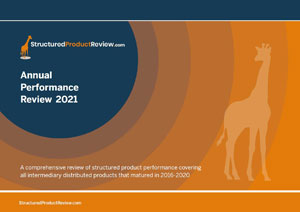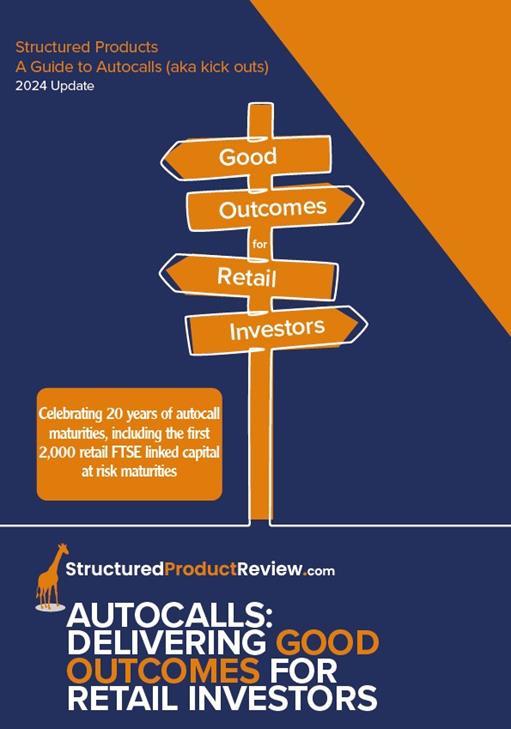05/06/2024
A decade ago the majority of capital protection barriers utilised in UK retail structured investments were what is known of as American Barriers. These were observed throughout the term of the investment. If on any day of the investment term the underlying closed below the barrier it was deemed to have been breached. In such an instance, if a subsequent early maturity was not triggered and at the end of the term the underlying closed below the initial level, even by a small amount, an equivalent loss would result.
When both types of barrier were common we at Lowes obviously preferred the European variety but that said, we would always assess to establish whether the additional risk of an American Barrier was being adequately, potentially compensated for to the extent that we may on occasion recommend a plan with a barrier observed throughout the term. At that time, it was common to see American Barriers at 50% with European Barriers at 60% and at these levels the contract pricing was such that they were considered close to equivalent in terms of risk.
Since 2018 all capital at risk retail plans issued in the UK have utilised the better, European Barriers. These have been typically set at 60% meaning that for a loss to arise from market movements the underlying needs to fall by 40% or more over the full term, however in the last two years 65% barriers have become the favoured choice whilst some have been at 70%. In assessing these barriers, it is important to again appreciate that they are only observed at the end of the term and then, only if the plan actually runs to that date. In this regard, two other important factors need to be taken into account; the length of time until the date when the barrier will ultimately be tested and the likelihood of the plan still being in force at that date. In this regard, two other sector changes need to be acknowledged; the extension to maximum terms and increased prevalence of autocalls.
Autocall structured products which now make up more than 80% of new issued capital at risk products provide multiple opportunities to mature early and as such, where the barrier is of the European / end of term variety, there is less chance of the plan ever reaching that date. As for maximum duration, the longer an autocall can potentially be in force, the greater the chance it will mature early and as such, never test the European barrier. Longer durations also provide more time for the underlying to recover from a correction occurring early in the investment term.
Historic back testing of FTSE 100 Index potential European barrier breaches
(Source: StructuredProductReview.com)
| European Barrier - observed at end of | Barrier Breaches at 60% of initial index level* | … With annual ATM KOs from year 1 | Barrier Breaches at 65% of initial index level* | … With annual ATM KOs from year 1 | Barrier Breaches at 70% of initial index level* | … With annual ATM KOs from year 1 |
| 5 years | 4 | 0 | 49 | 0 | 184 | 41 |
| 6 years | 0 | 0 | 0 | 0 | 1 | 0 |
| 7 years | 0 | 0 | 0 | 0 | 5 | 0 |
| 8 years | 6 | 1 | 27 | 6 | 119 | 20 |
| 9 years | 25 | 24 | 100 | 72 | 174 | 88 |
| 10 years | 10 | 0 | 57 | 9 | 111 | 9 |
*No potential for early maturity
It has to be acknowledged that the lower the barrier, the lower the risk and as such, we have no doubt that most investors would prefer a 50% barrier, only observed at the end of a potentially extended term and then, have multiple opportunities to potentially mature early and as such, never reach the barrier observation date. But of course, there is a trade-off and whilst it is possible to structure such a plan, the sacrifice in terms of the potential return on offer, which by all probability measures is likely to be achieved within the first six years, can be significant.
So why pay for protection you don’t need? There is balance to be achieved from assessing the likelihood of the plan not maturing early, running the full duration and ultimately breaching a barrier vs, it maturing early and never testing the barrier. In conducting such an assessment, one has to start from the position of knowing that you can’t predict future market movements and the risk of a catastrophic collapse from an unfactored issue is always present. However, a longer duration plan, with increased opportunities to mature, by definition also has longer for the market to recover if conditions are not favorable.
FTSE 100 Index since inception and the position of various barriers assuming an initial index level of 8,275 on 31 May 2024
(Source: Yahoo Finance)
Whilst there are assumption-based models which attempt to calculate the optimum position, it is unlikely that any of the assumptions used will prove to be completely accurate. It therefore often comes down to a degree of educated intuition and an assessment of perceived risk and reward.
Given that the better the protection, the lower the potential return the consensus is that a 70% barrier, observed only at the end of ten years is more appropriate than a 60% barrier with a corresponding reduction in potential coupon. This is particularly because the probability of the plan maturing early is many multiples the probability of the barrier being breached. In a similar vein, we feel that autocall plans with maximum terms of 7 or, 8 years could utilise 65% over 60% barriers, particularly where the plan has an increased number of maturity opportunities. That said, there are an increasing number of new plans being issued with 65% barriers and shorter maximum terms of five and six years and whilst the risk of loss from a barrier breach with such structures is undoubtably higher, it is still admittedly, very low.
As ever, it is important to appreciate that past performance is not a guide to the future and so back testing of strategies is only going to provide a statement of facts as to what would have happened historically. In that regard it should be recognised that the dot com boom, followed ten years later by the credit crisis crash, play a significant part in any FTSE 100 back test. An investment made in 1999 did not see the FTSE higher on a subsequent anniversary but it got close at the eighth, only to then collapse by the tenth. Given this scenario, out of over 10,000 possible start dates in the history of the FTSE 100 Index, there were 111 days when a 70% barrier observed at the end of ten years would have meant a loss arose, compared to just 57 for a 65% barrier.
Whilst those creating and distributing structured investments and indeed those investing in them, might be comforted by, and drawn to those strategies which can boast perfect back testing; with no days in history when commencing such a strategy would have given rise to a loss, the fallibility of relying on back testing and the fact that past performance is not a guarantee to the future can be evidenced by just a few more statistics:
Looking again at 70% European barriers on the FTSE 100, whilst there were 111 historic days when commencing a ten-year term fixed term plan would have ultimately given rise to a loss at maturity, where the maximum term was just six years, there was only one day that would have given a negative result.
Now consider the intuitively safer 65% European barriers on the same index. It is accurate to state that a 6 or 7-year fixed term plan, with a 65% European barrier would have never given rise to a loss, but that claim can’t be made for plans with terms of 5 years, 8, 9, or 10 years. Back testing can help shape thinking and perhaps give some comfort but analysts, advisers and investors should be discouraged from using it to define logic.
So, historically you would have had to have been very unlucky to have had a product with European barrier result in a loss from market movements over any term (in reality there were actually none) but the assessment needs to be, how much worse will the future performance of the market be, than in the past? Obviously, investors are, in part, being potentially rewarded for accepting the risk that the future will be much worse than the past but our view is that if you believe the FTSE 100 is not going to rise over the next ten years and is going to fall by more than 30% over that term any investment exposed to the market probably isn’t for you. For the rest of us however, whilst statistically the barriers on most autocalls are unlikely to ever be tested, the trade-off in terms of coupon, term and barrier level will continue to be a major differentiator in new product offerings.
Past Performance is not indicative of future results.
Structured investments put capital at risk.
Also in this section
- How old is too old? Are structured products to die for?
- Product focus - October 2024
- Q3 2024 Issuance
- Q3 2024 maturity results
- A share of spread bets on steroids?
- Product focus - September 2024
- Maturities of the month - August 2024
- Right on time
- Product focus - August 2024
- Keep calm and zoom out
- 2,000 and counting
- Q2 2024 maturity results
- 20 years of autocall maturities
- Product focus - June 2024
- Fixed income or interest?
- Maturities of the month - May 2024
- The barrier debate - revisited
- Product focus - April 2024
- Maturities of the month - April 2024
- Time to call
- I don't believe markets are ever too high for Structured products!
- Notes on counterparty exposure
- Return of Nikkei
- Q1 2024 issuance
- Q1 2024 maturity results
- Structured Products – AAAAAGH!
- Hop in CIBC
- Re-enter Santander
- How to build a financial fortune - revisited
- Issuance in 2023
- Where's the risk?
- Questionable offerings
- Challenging the case against structured products - 'Loss of dividends'
- Navigating the investment landscape
- Challenging the case against structured products - Counterparty risk
- 6-year autocalls approaching final destination
- 1,750 FTSE capital at risk autocall maturities
- The leopard that changed her spots
- Q3 2023
- Challenging the case against structured products - Keydata
- Dilemmas for UK IFA's and the unique role of Structured Products
- 'High charges'
- Precipice bonds
- Intro
- FTSE 100 Contingent Income
- Indexing the indices
- Something different
- Investing through volatility
- 100 10:10s
- The best or worst?
- The 10%/25% 'Rule' that never was
- Structured products and the yield curve
- Fixed income: Capital at risk?
- Prospects for UK inflation - and fun with A.I!
- The Barrier Debate
- More Deposits for now
- Last of the Americans
- What if?
- Time heals all wounds, we hope...
- How to diversify portfolios using structured products?
- The Proof Is In The Pudding...
- Debunking Structured Misconceptions
- 1,500 FTSE Capital-at-Risk Autocall Maturities
- Q3 2022 Maturity Results
- What do we prefer?
- Deposits vs Capital ‘Protected’
- There’s time yet…
- Where did you invest your clients?
- A Six-Month Reflection
- Return of the Rev Con
- Happy 2nd Birthday FTSE CSDI
- Q2 2022 Maturity Results
- The best and worst yet still the best
- Critique my Suitability - Mariana 10:10 Plan June 2022 (Option 2)
- 10/10 for 55 10:10’s
- Q1 2022 Maturity Results
- 'How to build a financial fortune': a follow up
- Critique my Suitability - Mariana 10:10 Plan April 2022 (Option 2)
- 2021 Capital-at-Risk Autocall Maturity Review
- An unwelcome return...
- CSDI's First Birthday
- Bon Anniversaire
- Introducing the FTSE Custom 100 Synthetic 3.5% Fixed Dividend Index
- Q3 2021 Maturity Results
- Critique my Suitability - Mariana 10:10 Plan October 2021 (Option 2)
- Blurring the lines...
- Beware of false knowledge; it is more dangerous than ignorance
- Good news, bad news...
- Certainty is Certainly a Benefit
- Critique my Suitability - Mariana 10:10 Plan September 2021 (Option 2)
- A Twenty-Year Progression
- Q2 2021 Maturity Results
- Nine 8:8s Post Positive Returns in Falling Markets
- Critique my Suitability
- Q1 2021 Maturity Results
- Morgan Stanley’s Marvelous Maturity Medley
Current Products
We review the UK's retail structured investment sector, providing pertinent support for Professional Advisers and relevant research tools.
View all ⟶


